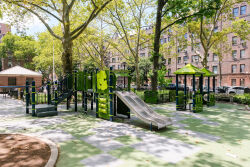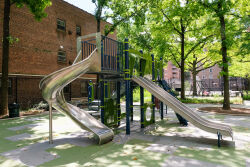Maple Playground
Maple Playground
What was here before?
This property was once home to the Matinecock people until European settlers arrived in the early 17th century, dispossessing the natives of their land. In 1645, Flushing, then known as the town of Vlissingen, received a charter from the Dutch West India Company. English immigrant and Quaker, John Bowne (1627–1695), and his family settled in this region. After New Netherland’s Director General Peter Stuyvesant banned colonists from hosting Quakers in their homes, Bowne lead the struggle for religious freedom, which led to the creation of the 1657 Flushing Remonstrance, often considered the precursor to the Constitution’s First Amendment.
Over the centuries, the land was subdivided as Queens developed and this property passed through various private owners. Samuel A. Salvage (1876-1946) acquired this property from Mary Arden Schroeder in 1915, several years after marrying Flushing native Mary Katherine Richmond (d. 1964). This property was a short distance from his mother-in-law’s home on Sanford Avenue. Salvage was a British businessman who became a textile magnate known as “the father of rayon industry in the United States,” and was knighted in 1942 for his contributions. The Salvages built an opulent estate, “Rynwood,” in Old Brookville, NY and moved there in 1927, but retained this Flushing property.
How did this site become a playground?
In 1942 the Salvages donated this property to the City of New York to be used as a park or playground, with the condition that the park be named Richmond Park, after Katerine’s mother the late Mrs. David Richmond. A garage from their original residence remained on site for several years, which the City made available for rent.
A decade later the land was developed into a playground. When it opened in 1954, it was the 626th playground in the park system and included a sitting area, sandpit, seesaws, kindergarten slide, public bathroom, wading pool, swings, and sports courts.
The playground was renovated several decades later, and in 2023 NYC Parks enlarged the playscape and relocated the children's play area to the shaded east side of the park, which included new play equipment, swings, and a water play area. The basketball court was also reconstructed and three ping pongs tables installed. While the park was originally called Richmond Park, it became known as Maple Playground, after adjacent Maple Avenue.
What is this playground named for?
Maples are one of approximately 200 tree species classified in the Acer genus. They are widely distributed throughout the northern temperate zone, with prevalence in China. Because of their diverse size, foliage, shapes, and colors, maples are used extensively for ornamental purposes.
Check out your park's Vital Signs
Clean & Safe
Green & Resilient
Empowered & Engaged Users
Share your feedback or learn more about how this park is part of a
Vital Park System










